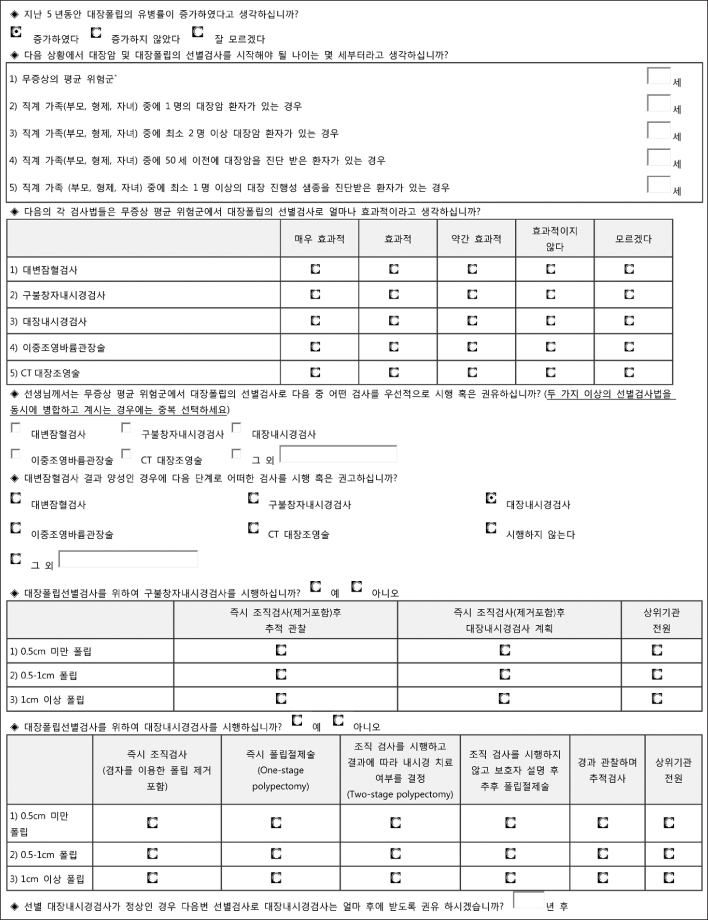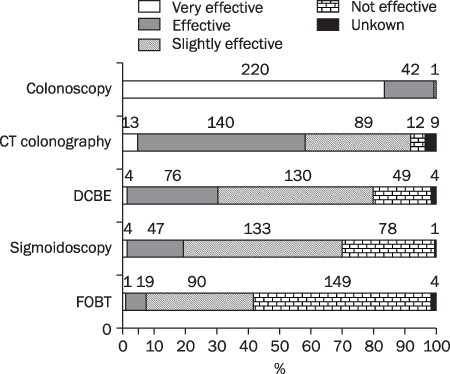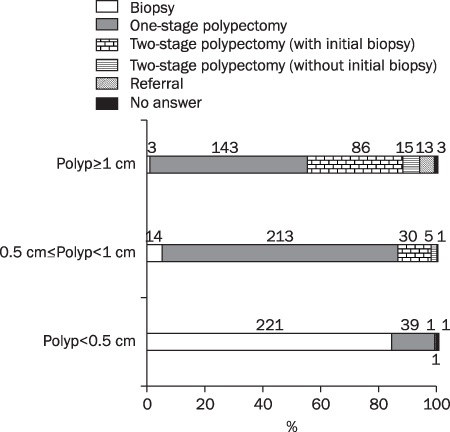A Korean National Survey for Colorectal Cancer Screening and Polyp Diagnosis Methods Using Web-based Survey
- Affiliations
-
- 1Department of Internal Medicine, Ewha Womans University School of Medicine, Seoul, Korea.
- 2Department of Internal Medicine, Yonsei University College of Medicine, Seoul, Korea.
- 3Department of Internal Medicine, Yonsei University Wonju College of Medicine, Seoul, Korea. hyskim@yonsei.ac.kr
- 4Department of Internal Medicine, The Catholic University of Korea, College of Medicine, Seoul, Korea.
- 5Department of Radiology, Seoul National University College of Medicine, Seoul, Korea.
- 6Department of Internal Medicine, Konkuk University School of Medicine, Seoul, Korea.
- 7Department of Gastroenterology, Ulsan University College of Medicine, Seoul, Korea.
- 8Department of Internal Medicine, Soon Chun Hyang University College of Medicine, Seoul, Korea.
- 9Department of Gastroenterology, Ajou University School of Medicine, Seoul, Korea.
- 10Department of Internal Medicine, Kangbuk Samsung Hospital, Sungkyunkwan University School of Medicine, Seoul, Korea.
- 11Department of Internal Medicine, Samsung Medical Center, Sungkyunkwan University School of Medicine, Seoul, Korea.
- 12Department of Internal Medicine, Kyunghee University College of Medicine, Seoul, Korea.
- KMID: 1718463
- DOI: http://doi.org/10.4166/kjg.2012.60.1.26
Abstract
- BACKGROUND/AIMS
There is a paucity of national guideline for colorectal cancer screening and polyp diagnosis in Korea. Thus, we investigated the present state of colorectal cancer screening and polyp diagnosis methods using web-based survey to use as reference data for developing a guideline.
METHODS
A multiple choice questionnaires of screening recommendations was sent via e-mail to members of the Korean Association for the Study of Intestinal Diseases and primary care physicians who participated in the national colonoscopy surveillance program. Among 425 colonoscopists, a total 263 colonoscopists replied (response rate, 61.9%).
RESULTS
The most commonly recommended starting age for colorectal cancer screening and polyp diagnosis was 50 years old in the average risk group, and 40 years old in groups who had a family history of colon cancer (64.3% and 65.0% respectively). Surgeons had a tendency to recommend screening in younger people than internist do. Ninety-eight percent of physicians recommended screening colonoscopy to asymptomatic, average-risk patients as a first choice. Only 2% of physicians chose sigmoidoscopy as a screening tool. When the initial colonoscopy showed a negative finding, over 60% of internists repeated the exam 5 years later, whereas 62% of surgeons did so within 3 years.
CONCLUSIONS
The starting age of colorectal cancer screening and the interval of the colorectal polyp examination are not uniform in various medical environments, and there is a discrepancy between the practical recommendations and western guidelines. Thus, a new evidence-based national practice guideline for colorectal cancer screening and polyp diagnosis should be developed.
MeSH Terms
Figure
Cited by 5 articles
-
Gender-specific Colorectal Cancer: Epidemiologic Difference and Role of Estrogen
Hee Man Kim, Hyun-Soo Kim
Korean J Gastroenterol. 2014;63(4):201-208. doi: 10.4166/kjg.2014.63.4.201.Randomized Controlled Trial of Sodium Phosphate Tablets versus 2 L Polyethylene Glycol Solution for Bowel Cleansing prior to Colonoscopy
Yun Ho Lee, Seong Yeon Jeong, You Sun Kim, Hye Jin Jung, Min Jung Kwon, Cheol Hun Kwak, Song I Bae, Jeong Seop Moon, Ji Won Kim, Su Hwan Kim, Kook Lae Lee
Korean J Gastroenterol. 2015;65(1):27-34. doi: 10.4166/kjg.2015.65.1.27.Formulation and Management of Poor Bowel Preparation: A Survey Study
Jae Ho Seong, Jin Sae Yoo, Kyong Joo Lee, Hong Jun Park, Hee Man Kim, Jae Woo Kim, Hyun-Soo Kim
Korean J Gastroenterol. 2016;68(2):70-76. doi: 10.4166/kjg.2016.68.2.70.Endoscopic Instruments and Electrosurgical Unit for Colonoscopic Polypectomy
Hong Jun Park
Clin Endosc. 2016;49(4):350-354. doi: 10.5946/ce.2016.059.A survey of current practices in post-polypectomy surveillance in Korea
Jeongseok Kim, Tae-Geun Gweon, Min Seob Kwak, Su Young Kim, Seong Jung Kim, Hyun Gun Kim, Eun Ran Kim, Sung Noh Hong, Eun Sun Kim, Chang Mo Moon, Dae Seong Myung, Dong Hoon Baek, Shin Ju Oh, Hyun Jung Lee, Ji Young Lee, Yunho Jung, Jaeyoung Chun, Dong-Hoon Yang
Intest Res. 2024;22(2):186-207. doi: 10.5217/ir.2023.00109.
Reference
-
1. Jung KW, Park S, Kong HJ, et al. Cancer statistics in Korea: incidence, mortality and survival in 2006-2007. J Korean Med Sci. 2010. 25:1113–1121.2. Shin HR, Won YJ, Jung KW, et al. Nationwide cancer incidence in Korea, 1999~2001; first result using the national cancer incidence database. Cancer Res Treat. 2005. 37:325–331.3. Winawer S, Fletcher R, Rex D, et al. Gastrointestinal Consortium Panel. Colorectal cancer screening and surveillance: clinical guidelines and rationale-Update based on new evidence. Gastroenterology. 2003. 124:544–560.4. Lee BH, Jeong SY. Korean National Recommendation Guidelines on Screening and Surveillance for Early Detection of Colorectal Cancers. J Korean Med Assoc. 2002. 45:981–991.5. Hong SN, Yang DH, Kim YH, et al. Multi-society task force for the guidelines for colorectal polyp screening, surveillance and management. A Survey for post-polypectomy surveillance. Intest Res. 2011. 9:118–128.6. Arditi C, Peytremann-Bridevaux I, Burnand B, et al. EPAGE II Study Group. Appropriateness of colonoscopy in Europe (EPAGE II). Screening for colorectal cancer. Endoscopy. 2009. 41:200–208.7. Davila RE, Rajan E, Baron TH, et al. Standards of Practice Committee, American Society for Gastrointestinal Endoscopy. ASGE guideline: colorectal cancer screening and surveillance. Gastrointest Endosc. 2006. 63:546–557.8. Bond JH. Practice Parameters Committee of the American College of Gastroenterology. Polyp guideline: diagnosis, treatment, and surveillance for patients with colorectal polyps. Am J Gastroenterol. 2000. 95:3053–3063.9. Levin B, Lieberman DA, McFarland B, et al. American Cancer Society Colorectal Cancer Advisory Group. US Multi-Society Task Force. American College of Radiology Colon Cancer Committee. Screening and surveillance for the early detection of colorectal cancer and adenomatous polyps, 2008: a joint guideline from the American Cancer Society, the US Multi-Society Task Force on Colorectal Cancer, and the American College of Radiology. Gastroenterology. 2008. 134:1570–1595.10. Rex DK, Johnson DA, Anderson JC, Schoenfeld PS, Burke CA, Inadomi JM. American College of Gastroenterology. American College of Gastroenterology guidelines for colorectal cancer screening 2009 [corrected]. Am J Gastroenterol. 2009. 104:739–750.11. U.S. Preventive Services Task Force. Screening for colorectal cancer: recommendation and rationale. Am Fam Physician. 2002. 66:2287–2290.12. Park DI, Ryu S, Kim YH, et al. Comparison of guaiac-based and quantitative immunochemical fecal occult blood testing in a population at average risk undergoing colorectal cancer screening. Am J Gastroenterol. 2010. 105:2017–2025.13. Lee SH, Lee KS, Lee JY, et al. Clinical usefulness of fecal occult blood test as a screening method for asymptomatic patients with colon polyps. Korean J Gastroenterol. 2006. 48:388–394.14. Morikawa T, Kato J, Yamaji Y, Wada R, Mitsushima T, Shiratori Y. A comparison of the immunochemical fecal occult blood test and total colonoscopy in the asymptomatic population. Gastroenterology. 2005. 129:422–428.15. Johnson CD, Chen MH, Toledano AY, et al. Accuracy of CT colonography for detection of large adenomas and cancers. N Engl J Med. 2008. 359:1207–1217.16. Pickhardt PJ, Hanson ME, Vanness DJ, et al. Unsuspected extracolonic findings at screening CT colonography: clinical and economic impact. Radiology. 2008. 249:151–159.17. Gluecker TM, Johnson CD, Wilson LA, et al. Extracolonic findings at CT colonography: evaluation of prevalence and cost in a screening population. Gastroenterology. 2003. 124:911–916.18. Lewis JD, Ng K, Hung KE, et al. Detection of proximal adenomatous polyps with screening sigmoidoscopy: a systematic review and meta-analysis of screening colonoscopy. Arch Intern Med. 2003. 163:413–420.19. Griffith JM, Lewis CL, Brenner AR, Pignone MP. The effect of offering different numbers of colorectal cancer screening test options in a decision aid: a pilot randomized trial. BMC Med Inform Decis Mak. 2008. 8:4.20. Atkin WS, Edwards R, Kralj-Hans I, et al. UK Flexible Sigmoidoscopy Trial Investigators. Once-only flexible sigmoidoscopy screening in prevention of colorectal cancer: a multicentre randomised controlled trial. Lancet. 2010. 375:1624–1633.21. Singh H, Turner D, Xue L, Targownik LE, Bernstein CN. Risk of developing colorectal cancer following a negative colonoscopy examination: evidence for a 10-year interval between colonoscopies. JAMA. 2006. 295:2366–2373.22. Bressler B, Paszat LF, Chen Z, Rothwell DM, Vinden C, Rabeneck L. Rates of new or missed colorectal cancers after colonoscopy and their risk factors: a population-based analysis. Gastroenterology. 2007. 132:96–102.23. Lakoff J, Paszat LF, Saskin R, Rabeneck L. Risk of developing proximal versus distal colorectal cancer after a negative colonoscopy: a population-based study. Clin Gastroenterol Hepatol. 2008. 6:1117–1121.24. Baxter NN, Goldwasser MA, Paszat LF, Saskin R, Urbach DR, Rabeneck L. Association of colonoscopy and death from colorectal cancer. Ann Intern Med. 2009. 150:1–8.25. Imperiale TF, Wagner DR, Lin CY, Larkin GN, Rogge JD, Ransohoff DF. Results of screening colonoscopy among persons 40 to 49 years of age. N Engl J Med. 2002. 346:1781–1785.26. Lieberman DA, Holub JL, Moravec MD, Eisen GM, Peters D, Morris CD. Prevalence of colon polyps detected by colonoscopy screening in asymptomatic black and white patients. JAMA. 2008. 300:1417–1422.27. Betés M, Muñoz-Navas MA, Duque JM, et al. Use of colonoscopy as a primary screening test for colorectal cancer in average risk people. Am J Gastroenterol. 2003. 98:2648–2654.28. Choe JW, Chang HS, Yang SK, et al. Screening colonoscopy in asymptomatic average-risk Koreans: analysis in relation to age and sex. J Gastroenterol Hepatol. 2007. 22:1003–1008.29. Lieberman D. Endoscopic colon screening: is less more? Gastroenterology. 1996. 111:1385–1387.30. Sung JJ, Lau JY, Young GP, et al. Asia Pacific Working Group on Colorectal Cancer. Asia Pacific consensus recommendations for colorectal cancer screening. Gut. 2008. 57:1166–1176.31. Levin B, Lieberman DA, McFarland B, et al. American Cancer Society Colorectal Cancer Advisory Group. US Multi-Society Task Force. American College of Radiology Colon Cancer Committee. Screening and surveillance for the early detection of colorectal cancer and adenomatous polyps, 2008: a joint guideline from the American Cancer Society, the US Multi-Society Task Force on Colorectal Cancer, and the American College of Radiology. CA Cancer J Clin. 2008. 58:130–160.32. Morson BC. Evolution of cancer of the colon and rectum. Cancer. 1974. 34:Suppl. 845–849.33. Kato H, Haga S, Endo S, et al. Lifting of lesions during endoscopic mucosal resection (EMR) of early colorectal cancer: implications for the assessment of resectability. Endoscopy. 2001. 33:568–573.
- Full Text Links
- Actions
-
Cited
- CITED
-
- Close
- Share
- Similar articles
-
- Trends in Cancer-Screening Rates in Korea: Findings from the National Cancer Screening Survey, 2004-2023
- Cost Effectiveness of Interventions to Promote Screening for Colorectal Cancer: A Randomized Trial
- Trends in Cancer Screening Rates among Korean Men and Women: Results from the Korean National Cancer Screening Survey (KNCSS), 2004-2010
- Trends in Cancer Screening Rates among Korean Men and Women: Results from the Korean National Cancer Screening Survey (KNCSS), 2004-2011
- Trends in Cancer Screening Rates among Korean Men and Women: Results of the Korean National Cancer Screening Survey, 2004–2018






